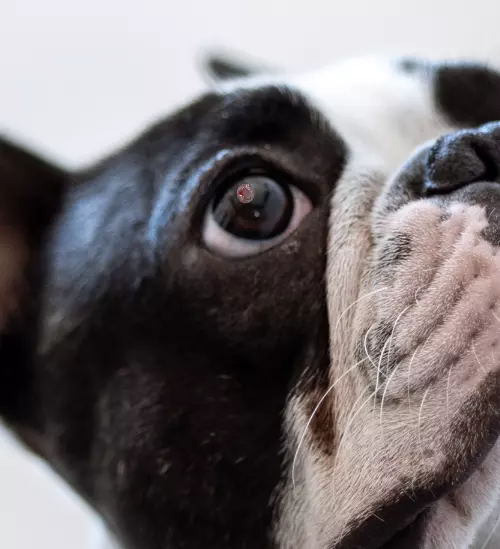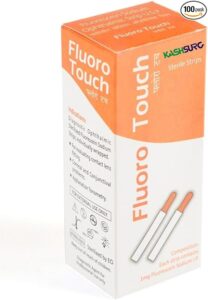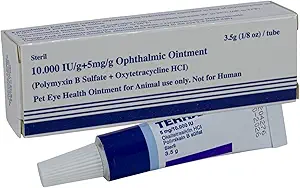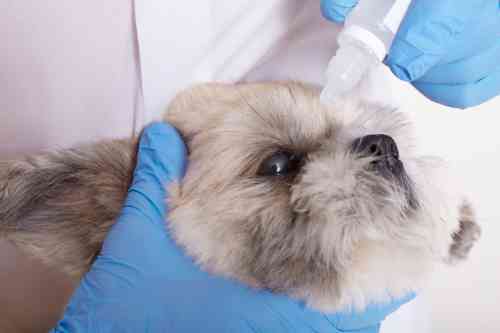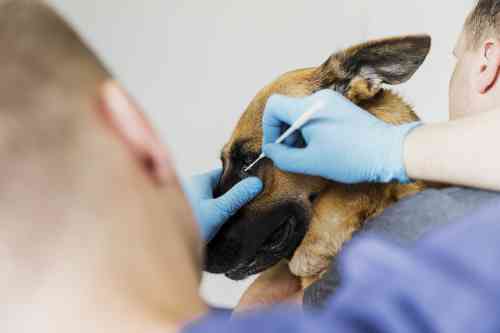Eye ulcer (corneal ulcer) treatment for dogs
An eye ulcer in dogs, also known as a corneal ulcer, is a wound on the transparant part of the eyeball of a dog. If this wound gets infected with bacteria it will not be able to heal on its own. When the ulcer will not be treated the eyeball will burst open in the end and his eye will be lost forever. So you really need to treat his eye ulcer. In this article we explain what the best treatment for dogs with an eye ulcer is.
Symptoms of an eye ulcer in dogs
It is not always very clear if a dog has an eye ulcer or not. The symptoms are not specific for the eye ulcer. But most of the time you will see the following symptoms in a dog with an eye ulcer:
- Squinting his eye
- Rubbing eye with paw or objects
- Tears forming in his eye, with wet fur in the corner
- When the ulcer is already a few days old there might be a white blurry spot visible in the cornea of the eye
- The white part of the eye may have turned red
- Your dog may find bright light painfull to look at
How to diagnose an eye ulcer in dogs?
You can diagnose an eye ulcer in dogs with a fluorescein test. Put a drop of water on the orange part of the fluorescein strip (see below) and let this drop touch the eyeball of the troubled eye. This way the orange color will adhese to the tissue that is exposed in the wound on the cornea. You can best shine a light on the eye and look for a green spot or stripe on the eyeball. If you see one, use the eyelids to check if the green dot can be moved over the eyeball. If not, unfortunately your dog has an eye culcer and needs treatment.
An eye ulcer explained
See the image below. It’s an image of a cross section of the cornea when you cut through the eye and place a piece of the cornea under the microscope. The outer and inner layers of the cornea are very tightly packed cells. The orange arrows point to these layers. The middle layer (green arrow) is a bit messy with lots of fibers. The orange dye that you use to determine if there is a wound in the outer layer of the cornea, adheres to these fibers in the middel part of the corna. In the eye the dye turns green. If the outer cell layer is not damaged, the orange dye cannot adhere to the eye and simply washes away. There is nothing to see on the eye.
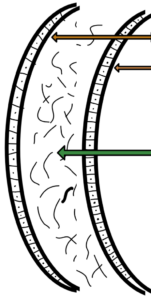
When you dog does have a scratch on his cornea, the outer layer of the cornea is gone, and the middle layer is exposed to the outside world. The orange fluoresein stains the middle layer. And that way you can see how big the wound on the cornea really is. It helps to see it better when you use a light to shine on the eye after you put in the orange dye. But remember that sometimes bright light hurts your dog’s eye if there is a corneal ulcer.
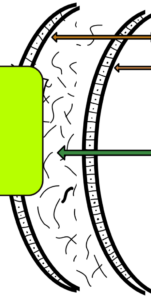
Treatment of an eye ulcer in dogs
In most of the cases your dog is capable to heal the ulcer on his own. But a bacterial infection can easily occur there. That is why it is best to treat the eye twice a day with an antibacterial ointment until the ulcer has healed. Normally this takes about tree to four weeks. After four weeks of ointment twice a day you repeat the orange fluorescein test. If there is no longer a green dot or stripe on the cornea visible you can stop the treatment. If it is still visible you need to keep on treating the eye with the antibacterial ointment. Only after a test that tells you that the ulcer has healed you can stop with the ointment.
Ulcer doesn’t heal in your dog
Sometimes, however, the ulcer does not heal. The outer cell layer is growing back, but does not want to attach properly to the messy middel layer. In that case, it is necessary to scratch off the damaged layer under anesthesia (sometime without is posible) and make a fresh wound on the cornea. Often, the choice is made to immediately loosen a layer of mucous membrane from the inside of the eyelids and stitch this over the damaged part of the eye. The eyelid can’t open then (temporarily). That way the blood vessels from the mucous membrane grow well into the cornea and more nutrients reach the ulcer. That way there is a bigger chance of healing. Later, during a second operation, the eyelid is then completely detached from the eyelid so that the eye can be opened again. The eye itself is saved, but a scar remains on the eye that might reduce a bit of his vision. Hopefully this is procedure is not necessary in your dog. Good luck!

